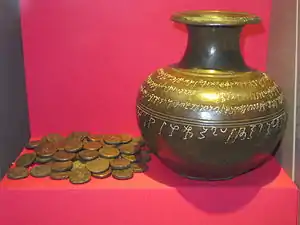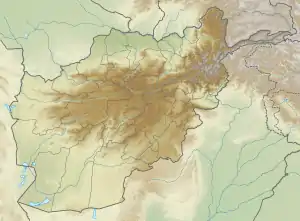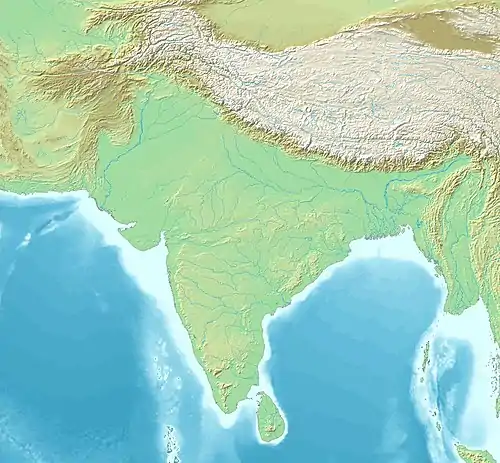Wardak Vase
The Wardak Vase is the name of an ancient globular-shaped buddhist copper vase that was found as part of a stupa relic deposit in the early nineteenth century near Chaki Wardak in Wardak Province, Afghanistan. The importance of the vase lies in the long Kharoshthi inscription, which claims that the stupa contained the relics of the Buddha. Since 1880, the vase has been part of the British Museum's Asian collection.[1][2]
| Wardak Vase | |
|---|---|
 Wardak Vase and coins displayed in the British Museum | |
| Material | Copper alloy |
| Size | Height 17.8 cm |
| Created | 2nd Century AD |
| Present location | British Museum, London |
| Registration | OA 1880-93;CM 1979-2-15-21 to 41 |
 Wardak  Wardak | |
Discovery
The vase, coins and other relics were found by the British adventurer and spy Charles Masson in 1836. Mason unearthed the vase in one of the stupas near the town of Wardak. The finds were sent to London in 1839, where they became part of the Indian Museum's collection. In 1880, they were transferred to the British Museum.
Description
The Wardak Vase is spherical in shape and made of copper alloy. The vase has a slim neck with an inverted rim and a low flat base. It has a series of three parallel grooves running around the middle of the vase (with a further two pairs of grooves above and below). Engraved between the upper and middle grooves are four lines of Kharoshthi script that dates the vase and deposit to the year 178 AD. With the vase were found a number of beads and sixty-six coins of the Kushan Kings Vima Kadphises, Kanishka I and Huvishka.
Inscription
The long inscription refers to the Kushan year 51 in the reign of Kanishka I who reigned between AD 110 and 120, but also refers to one of his successors Huvishka, who ruled between AD 146 and 83; it thus provides useful evidence for reconstructing the chronological reigns of Kushan royalty at the time. The inscription also indicates that the monastery was built by the Mahasanghikas, one of the earliest buddhist schools in India, who were based at Mathura, near Delhi. The vase therefore provides strong evidence for the widespread distribution of Buddhism in South Asia almost 2000 years ago.
Translation of the Inscription
A translation of the inscription is described below:
"In the 51st year, in the month Artemisios, after 15 (days), at this time Vag̱amareg̱a, son of Kamagulya; he has made his abode here in Khavada (and) establishes in the Vag̱amareg̱a monastery in a stūpa a relic of the Lord, the Śākya sage."
Further reading
- Baums, Stefan. 2012. “Catalog and Revised Texts and Translations of Gandharan Reliquary Inscriptions.” In: David Jongeward, Elizabeth Errington, Richard Salomon and Stefan Baums, Gandharan Buddhist Reliquaries, p. 243–244, Seattle: Early Buddhist Manuscripts Project (Gandharan Studies, Volume 1).
- Baums, Stefan, and Andrew Glass. 2002– . Catalog of Gāndhārī Texts, no. CKI 159
- Errington, E., and J. Cribb (eds), The Crossroads of Asia: (Cambridge, Ancient India and Iran Trust, 1992)